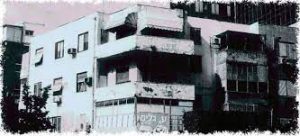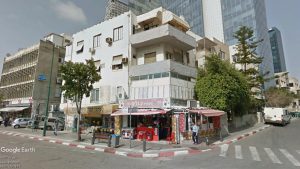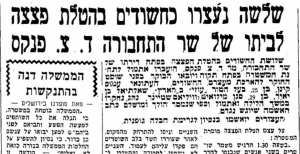Article author: Miky Weinberg – Owner of the Tarantula Technologies Ltd and Octagon Security Ltd Companies.
Minister David Zvi Pinkas was the first public elected official who had an assassination attempt on his life since the establishment of the State of Israel. David Zvi Pinkas was an Israeli politician, one of the signatories of the Declaration of Independence, and the third Minister of Transportation on behalf of the Mizrahi Party of the State of Israel from October 8, 1951, until his death from a heart attack on August 14, 1952. On Saturday night, June 20, 1952, a bomb was placed on the porch of David Zvi Pinkas, who lived at 6 Ramchal Street in Tel Aviv. The bomb did not explode, so the next day the assassins placed another bomb, this time near the door of his house.
The reason for the assassination – controversy over the issue of religious coercion:
Already during the Yishuv period, the tension between religion and secularism that characterized the Jewish pioneering efforts was the subject of heated debates that had the potential to be explosive, literally. The first prime minister of the State of Israel, David Ben-Gurion, was completely secular, but in the same breath, he was the same Ben-Gurion who wrote the “status quo letter” in 1947, which he sent as chairman of the Jewish Agency to Agudat Israel with lines for the status quo in religious matters for the forming country. Already with the formation of the first government, Ben-Gurion decided that his Mapai party would form a coalition with the United Religious Front and not with the left-wing Mapam Party or the Revisionist Herut party. The attitude towards religion and state issues that had been formed since the dawn of the state was that they had to be resolved through “politics of arrangements”, thus avoiding a sharp and resounding unilateral majority decision and arrangement by way of dialogue and agreement.
The first governments known to the state did not last long, and in some cases fell for reasons directly or indirectly related to religion. For example, the second government ended in February 1951, about four months after its establishment, following Ben-Gurion’s resignation due to disagreements with the religious parties over the provision of religious education for the children of the immigrants.
As mentioned, David Zvi Pinkas served as Minister of Transportation in the third government headed by Ben-Gurion, a government that was required to deal with days of austerity, rationing, and scarcity. As part of the directive to reduce fuel use, Pinkas ordered that vehicles would be stopped for two days a week, with one of those days being Saturday. The installation provoked a public scandal and was perceived as religious coercion under the guise of economic constraint.
The assassins:
The assassins were Haaretz writer and journalist Amos Keinan and Shaltiel Ben Yair, who was a sabotage expert in his military service, both of them belonged to the pre-state militia Lehi. Both of them thought something needed to be done and to personally protest the minister’s actions.
The course of action chosen for the assassination was an explosive device:
Placing a bomb in official institutions as a means of shocking decision-makers and the public in the face of a controversial issue was not an unusual act in those days. Those who were in the underground militias who felt that the new state was breaking a promise, sometimes decided that they were acting by the old means they knew. The arsenal of explosives they and their comrades have been caching since the War of Independence has been retrieved. The members of the underground did not break free so quickly from the atmosphere of terror in which they lived for years. They refused to digest that they were no longer fighting the British, but their own people from their nation. Placing a bomb on the Czechoslovakian embassy and at the sensational weekly journal “HaOlam HaZeh”; an explosion at the Soviet embassy as well as explosives seized from yeshiva students who intended to use it to harm the Ministry of Education, in protest of the crystallization of a state education law perceived as threatening religious education – all of these are just examples of publicized reports of underground members, convictions for serious offenses. But concealing a bomb in a person’s private home was a far-reaching step.
The bomb was received by Amos Keinan from Yaakov Heruti, whom he knew from high school. After the assassination attempt, he published the following details: “Keinan came to me and asked for explosives. For what purpose? I asked. For a display of protest. I did not doubt that Amos was telling the truth. This was also impossible for us. We made an appointment and I brought him the explosive sticks. Amos had two left hands, but Shaltiel Ben Yair was a professional, and the rest is known. The bomb was detonated in Pinkas’s house. From that day on, I did not speak to Amos in good or bad times for 30 years. I rejected any attempt to associate with him”.
The assassination:
As stated, Minister David Zvi Pinkas lived in an apartment in a building at 6 Ramchal Street in Tel Aviv:


On Saturday night, June 20, 1952, the assassins placed a bomb on Pinkas’s porch. The bomb did not explode and was discovered by Pinkas’s son who called the police. Police set up ambushes near Pinkas’s home and the next day another bomb was placed, this time near his door. It exploded, causing environmental damage, but no one was hurt. The sequence of events in the same was published by the police:
At 01:30, a police guard sensed two people entering the stairwell of a house at 6 Ramchal Street in Tel Aviv. After 20 seconds the two persons went out and tried to move away from the place. After arousing the suspicion of the police officers, the officers ordered them to stand still, the two did not obey and continued to walk away. The officers pulled out their weapons and told the two persons to stand still and if they won’t, they will open fire. The two were arrested and handed over to the police station at 8 Yehuda Halevi Street. At that moment, an explosion was heard in the stairwell of the house that the two had left. The two policemen immediately went up to the stairwell and found the door of Pinkas’s apartment in the same building that it was broken into. The apartment is on the second floor on the left. The police sapper who arrived at the scene immediately discovered that the bomb that destroyed the door of the apartment was homemade.

The handling of the assassins:
During their detention, Keinan and Shaltiel maintained their right to remain silent, went on hunger strike in protest of their detention conditions, and did not admit to being involved in the incident. “I did not carry, I did not throw, I did not throw and I did not drop the bomb on the home of the Minister of Transportation Pinkas,” Keinan said in court. Only after the death of Pinkas did Keinan and Ben-Yair stand trial. They claimed to have arrived in the area innocently, after receiving an anonymous phone call. A civil judge who had no criminal experience was exceptionally appointed to their trial. The judge ruled that there was no doubt that the defendants were telling the truth, and acquitted them. An appeal was filed in the Supreme Court. The Supreme Court justices sharply criticized the judge, wondering why Keinan met in the middle of the night with a former commissioned officer who specializes in explosives. Despite this, they too strangely acquitted the defendants. Keinan later revealed to his associates that he indeed did carry out the assassination.
David Zvi Pinkas:
About two months after the assassination, Pinkas died of a sudden heart attack, he was only 57 years old. At the time of his death, a Tanach, the Pesachim Tractate, and work documents were found next to him. His family members linked his death to the attempt on his life and the contemptuous manner in which that was handled.
After Pinkas’s death, the third government did not last long: at the end of September 1952, Agudat Israel and Poalei Agudat Israel left the government due to the opposition of their members to the recruiting of women to the IDF. Three months later Ben Gurion also quit, again because of disagreements regarding religious education, and the government ended.
Video from the State Archives – Reporting on Pinkas’s Death (in the first part of the video):
In 1952, the prime minister and ministers in Israel were not secured. The security unit set up in 1958 has not yet been set up and therefore elected officials were exposed to one hundred percent harm except in cases where the police decided to act to secure them. Factually, in the assassination attempt on Pinkas’s life, the police placed an ambush around his home after the first explosive charge was placed on the porch and did not explode. I could not find an answer to the question of why the policemen who were in the ambush did not identify the assassins upon entering the building and did not prevent the placement of the second explosive device next to the door of the house. In recent years, ministers in Israel who are not secured by the Israel Security Agency, have been secured based on activity analysis and a situation assessment to determine the required level of security, except for placing security guards in homes that are defined as permanent facilities. There is no doubt that a security guard stationed at the minister’s house should locate any person who is not known and probably any suspicious object/charge placed in the threat area.